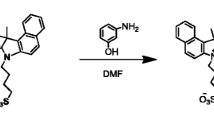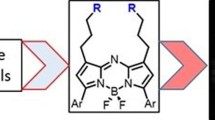Abstract
A novel naphthalimide molecule, 4-(2-methoxyethoxy)-N-butyl-1,8-naphthalimide (MEBN), has been synthesized and characterized. The UV–visible absorption and fluorescence emission spectral properties in n-hexane, toluene, CHCl3, and CH3OH were studied. Its optical properties depend on solvent polarity. The application of MEBN in cell imaging was investigated.
Similar content being viewed by others
Introduction
Derivatives of 1,8-naphthalimide usually exhibit strong fluorescence. They have been widely used as colorants in the polymer industry, fluorescent probes for medical and biological purposes, and as n-type materials in organic light-emitting diodes [1]; they are potential anti-HIV drugs, fluorescent cell markers, DNA-cleaving agents, liquid-crystal additives, and laser dyes [1].
The excellent fluorescent properties of commercial 1,8-naphthalimide compounds depend largely on the presence of strong electron-donating groups, typically such groups as alkoxy and alkylamine, at the C-4 position [2]. It is known that 4-alkoxy-1,8-naphthalimides have been widely used as fluorescent brightening agents. In this paper, a novel 4-alkoxy-1,8-naphthalimide compound, 4-(2-methoxyethoxy)-N-butyl-1,8-naphthalimide (MEBN) was prepared by a simple method. The UV–visible absorption and fluorescence emission spectral properties were studied. Application in cell imaging was investigated.
Experimental
Solvents and reagents were obtained from commercial sources. 1,8-Naphthalic anhydride was recrystallized from chlorobenzene before use. Other chemicals were analytical regents and used as received. Further purification and drying were employed by standard methods, and they were distilled before use when necessary. Melting points were determined with an XT4A apparatus and are uncorrected. Mass spectral studies were carried out using a VG12-250 mass spectrometer. 1H NMR and 13C NMR spectra were obtained on a Bruker DRX 400 MHz spectrometer. Chemical shifts are reported in ppm relative to Me4Si as standard. Carbon, nitrogen, and hydrogen were determined on an Elementar Vario EL. Steady-state emission and excitation spectra were recorded on a Perkin–Elmer LS55 instrument. Visible absorption spectra were determined on a Perkin–Elmer Lambda 35 spectrophotometer. Cell images were acquired by use of a luminescence microscope.
Preparation of 4-bromo-N-butyl-1,8-naphthalimide
A mixture of 4-bromo-N-butyl-1,8-naphthalic anhydride (5.0 g, 18 mmol), butylamine (1.7 g, 23.3 mmol), and 50 mL acetic acid was heated under reflux for 3 h under nitrogen. After cooling, the mixture was dissolved in 100 mL water. The crude solid was further purified by recrystallization from alcohol and 5.0 g white solid was obtained, Yield 83.5%. mp 109–110 °C. 1H NMR (500 MHz, CDCl3): δ 8.68 (d, J = 7.2 Hz, 1H), 8.59 (d, J = 8.4 Hz, 1H), 8.43 (d, J = 7.6 Hz, 1H), 8.06 (d, J = 8.0 Hz, 1H), 7.87 (t, J = 7.2, 7.2 Hz, 1H), 4.19 (t, J = 7.6, 7.6 Hz, 2H), 1.73 (m, 2H), 1.46 (m, 2H), 1.00 (t, J = 7.2, 7.2 Hz, 3H).
Preparation of MEBN
A 50-mL round-bottomed, one-necked flask was charged with 1.2 g (3.01 mmol) 4-bromo-N-butyl-1,8-naphthalimide, 4 mL 2-methoxyethanol, 0.096 g (0.503 mmol) CuI, and 1.96 g (20 mmol) K2CO3. The reaction mixture was heated under reflux for 3 h. After cooling, the mixture was extracted with ethyl acetate and dried over MgSO4. The crude solid was further purified by silica gel column chromatography using petroleum ether and ethyl acetate (5:1, v/v) as eluent to afford 1.1 g yellow solid, Yield 93%. mp 103–105 °C. 1H NMR (500 MHz, CDCl3): δ 8.61 (dd, J = 7.6, 2, 1.2 Hz, 2H), 8.54 (d, J = 8.4 Hz, 1H), 7.72 (t, J = 7.2, 8.4 Hz, 1H), 7.05 (d, J = 8.4 Hz, 1H), 4.44 (t, J = 4.4, 4.8 Hz, 2H), 4.18 (t, J = 7.2, 7.6 Hz, 2H), 3.95 (t, J = 4.4, 4.8 Hz, 2H), 3.54 (s, 3H), 1.72 (m, 2H), 1.46 (m, 2H), 0.98 (t, J = 7.6, 7.2 Hz, 3H). 13C NMR (CDCl3, 400 MHz) 14.08, 20.63, 29.90, 40.31, 59.59, 68.60, 70.90, 106.15, 115.56, 122.68, 123.74, 126.12, 128.94, 128.96, 129.61, 131.75, 133.47, 160.16, 164.15, 164.73. Ms: m/z = 327 (M+, 95.47%). Elemental analysis for: C19H21NO4 Calc.: C, 69.71; H, 6.47; N, 4.28. Found: C, 69.50; H, 6.49; N, 4.26.
Results and discussion
Synthesis
4-Alkoxy-1,8-naphthalimides have been obtained from naphthalimides substituted at the 4-position by electron-withdrawing groups by many procedures [3]. Most of the synthetic methods for preparation of 4-alkoxy-1,8-naphthalimides are based on nucleophilic aromatic substitution (SNAr) of halogens at the C-4 position by alkoxylating agents in dipolar aprotic solvents such as N-methylpyrrolidinone, DMF, and quinoline [3, 4]. Catalysts such as potassium or copper acetates and phase-transfer catalysts are commonly used [3]. Some of these reactions are carried out under reflux at high pressures up to 10 atm. The route to the synthesis of MEBN is presented in Scheme 1. MEBN was obtained by nucleophilic substitution of the bromide atom at the 4-position in 4-bromo-N-butyl-1,8-naphthalimide with a methoxyethoxy group under copper-catalyzed conditions and use the reactant 2-methoxyethanol itself as solvent. No phase-transfer catalyst is needed. In comparison with other literature procedures for synthesis of 4-alkoxy-N-substituted-1,8-naphthalimides, our method has the advantages of employing simple and mild conditions, having an easy work-up, and giving excellent yields.
Photophysical properties
The UV–visible absorption of MEBN in n-hexane, toluene, CHCl3, and CH3OH was recorded to study its spectral properties in various solvents of different polarity (Fig. 1). The wavelengths corresponding to the spectral peaks are shown in Table 1. As indicated in the absorption spectra, MEBN has a common low-energy broad band at 350–360 nm. MEBN has structured absorption (there appear to be two shoulder peaks) in nonpolar solvents such as hexane, which could be ascribed to the lowest π–π* transitions [4, 5]. On the other hand, bathochromic shifts in absorption due to solvent polarity were observed. For example, in hexane, MEBN had a λ max value at 355 nm and a red-shift in absorbance for the polar solvent methanol at 365 nm. It is interesting to compare the effect of the substituents at C-4 on the absorption spectrum. The absorption peak is observed at 355 nm for MEBN and 350 nm for 4-methoxy-N-butyl-1,8-naphthalimide (MBN) [4]. It can be seen that methoxyethoxy has stronger electron-donating ability than methoxy [4, 6–8].
The fluorescence spectra of MEBN are displayed in Fig. 2. It can be observed from Fig. 2 that the fluorescence emission spectra of MEBN were also sensitive to solvent polarity. They move gradually to lower energies with increasing solvent polarity (Table 1). The effect of the polarity of the medium on the photoluminescent maximum was more pronounced than for the absorption maximum. The long wavelength of fluorescence emission observed in more polar solvents is undoubtedly due to an intramolecular charge-transfer transition. This observation demonstrates the highly polar nature of the S1 excited state of MEBN [9, 10]. Comparing MEBN and MBN, by changing the methoxy in MBN with 2-methoxyethoxy, the fluorescence emission maximum (in hexane) is increased by approximately 16 nm. This behavior can be understood by taking into consideration the different electron-donating ability of the two substituents.
Cell imaging
To examine the potential of MEBN for imaging in cells, Hela cells were treated with 0.9% saline solution of MEBN (500 μg/mL, the cell culture medium was added also). The water solubility of MEBN is good. It was accordingly possible to directly employ a 0.9% saline solution of the dye without use of any solubilizing agent such as CrEL (polyoxyethylene castor oil) [11]. Cells were incubated at room temperature for 2 h and were then washed with aqueous PBS solution to remove excess unbound dye. The slides were mounted and imaged by epifluorescence microscopy. The one-photon epifluorescence microscopy images are presented in Fig. 3. From Fig. 3, it is clear the dye had good permeability. After 48 h of incubation, 73.9% of cells are alive, which indicates that the toxicity of MEBN is low (In contrast, 100% survival is observed for Hela cells not treated with MEBN [12].)
Conclusion
A novel naphthalimide molecule, MEBN, was synthesized by use of a simple method. The absorption and photoluminescent spectra of MEBN in various solvents were investigated. Its optical properties depend on solvent polarity. By fluorescence cell imaging with MEBN, it was found that MEBN has good cell permeability, low toxicity, and has potential in cell imaging techniques.
References
J. Wang, Y.M. Sun, X.L. Wang, Q. Wang, W.L. Xu, Dyes Pigm. 77, 125 (2008)
J.-X. Yang, X.-L. Wang, Tusong, L.-H. Xu, Dyes Pigm. 67, 27 (2005)
E.R. Triboni, R.G.S. Berlinck, M.J. Politi, P.B. Filho, J. Chem. Res. 2004, 508 (2004)
R. Badugu, J. Fluoresc. 15, 71 (2005)
B. Ramachandram, G. Saroja, N.B. Sankaran, A. Samanta, J. Phys. Chem. B 104, 11824 (2000)
S. Yao, K.J. Schafer-Hales, K.D. Belfield, Org. Lett. 9, 5645 (2007)
H.B. Xiao, L. Wang, X.M. Tao, M.J. Chen, Synth. Met. 160, 1313 (2010)
H.B. Xiao, H. Li, M.J. Chen, L. Wang, Dyes Pigm. 83, 334 (2009)
S. Wang, P.J. Zeng, Y.Q. Liu, G. Yu, X.B. Sun, H.B. Niu, D.B. Zhu, Synth. Met. 150, 33 (2005)
A. Jacobson, A. Petric, D. Hogenkamp, A. Sinur, J.R. Barrio, J. Am. Chem. Soc. 118, 5572 (1996)
L. Beverina, M. Crippa, M. Landenna, R. Ruffo, P. Salice, F. Silvestri, S. Versari, A. Villa, L. Ciaffoni, E. Collini, C. Ferrante, S. Bradamante, C.M. Mari, R. Bozio, G.A. Pagani, J. Am. Chem. Soc. 130, 1894 (2008)
D. Zheng, A. Bonoiu, T.Y. Ohulchanskyy, G.S. He, P.N. Prasad, Mol. Pharm. 5, 389 (2008)
Acknowledgments
This work was financially supported by the Innovation Program of Shanghai Municipal Education Commission (no. 09YZ160).
Open Access
This article is distributed under the terms of the Creative Commons Attribution Noncommercial License which permits any noncommercial use, distribution, and reproduction in any medium, provided the original author(s) and source are credited.
Author information
Authors and Affiliations
Corresponding author
Rights and permissions
Open Access This is an open access article distributed under the terms of the Creative Commons Attribution Noncommercial License (https://creativecommons.org/licenses/by-nc/2.0), which permits any noncommercial use, distribution, and reproduction in any medium, provided the original author(s) and source are credited.
About this article
Cite this article
Xiao, H., Chen, M., Shi, G. et al. A novel fluorescent molecule based on 1,8-naphthalimide: synthesis, spectral properties, and application in cell imaging. Res Chem Intermed 36, 1021–1026 (2010). https://doi.org/10.1007/s11164-010-0214-6
Received:
Accepted:
Published:
Issue Date:
DOI: https://doi.org/10.1007/s11164-010-0214-6








